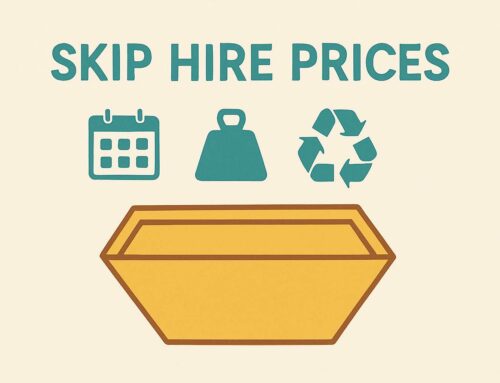Choosing the correct skip size is essential for efficient waste management for domestic clean-ups or large-scale construction projects. This guide provides a comprehensive overview of various skip sizes and how to select the most appropriate one for your needs. Understanding the right skip size ensures cost-effectiveness and compliance with legal regulations and reduces environmental impact.
Skips offer an efficient solution for managing waste of all types and quantities. Previously, waste disposal was a challenge, but booking a skip and removing all the waste is now simple. There are different skip sizes, which makes it convenient for all kinds of industries to book a skip according to their requirements.
Skips are available in many standard sizes, such as 2-yard, 4-yard, 6-yard, 8-yard, 12-yard, and 14-yard. The question often arises: Why are multiple sizes necessary when several trips with a single skip could work? Making multiple trips is often impractical, it can lead to inefficiency, increased costs, and a larger carbon footprint. To make things convenient and remove waste in a single trip, different skip sizes have been introduced with wide range of skip hire prices.
Factors to Consider When Choosing a Skip Size
Assessment of Waste Type and Volume
The type and volume of waste are pivotal in deciding the skip size. For instance: Domestic waste, Such as garden debris or old furniture, usually requires smaller skips.
Construction debris, Including concrete, bricks, or timber, may need larger, robust skips. Volume Estimation A crucial step to avoid overfilling. Consider both the amount and bulkiness of waste.
Space Availability and Skip Placement
- Site Access: Ensure the chosen skip size can be delivered and placed at your site. Larger skips need more space and robust access.
- Permits: A council permit is often required if the skip is placed on a public road. The size of the skip might affect permit availability.
Legal and Environmental Considerations
- Waste Disposal Laws: Different regions have varying regulations on waste disposal, which can influence the choice of skip size.
- Recycling and Environmental Impact: Select a skip size that aligns with recycling policies. Larger skips might encourage the segregation of recyclable materials.
Duration of the Project
Short-Term vs. Long-Term Projects: Smaller skips may suffice for short-term projects, whereas longer projects might benefit from larger skips to minimise disposal frequency.
Skip Size Details – Choose the Perfect Skip Size for Your Needs
Skips come in various sizes, making them versatile for all kinds of work, from simple DIY to garden clearance and industrial waste removal. However, hiring a skip only benefits when selecting the correct skip size. Here is our skip size guide:
-
2 Yard Skips
This is the smallest skip size suitable for household and domestic waste. It can accommodate around 25-35 bags of black bin. This mini skip size is also ideal for kitchen and bathroom refitting.
Usage: Ideal for small domestic projects, such as garden clean-ups or minor DIY tasks.
Capacity: Can hold approximately 25-35 black bin bags.
Dimensions: Typically around 4 feet long, 3 feet wide, and 3 feet high. -
4 Yard Skips
Suitable for lightweight, smaller quantities of waste that can’t fit into a mini skip. It is good for household waste and small garden waste. It can accommodate 40-50 black bin bags.
Usage: Suitable for small to medium home renovation projects, such as bathroom refits.
Capacity: Holds about 40-50 black bin bags.
Dimensions: 6 feet long, 4.3 feet wide, and 3.2 feet high. -
6 Yard Skips
Ideal for kitchen, bathroom, garden cleanups, and small construction projects. This size can hold approximately 50-70 black bin bags.
Usage: Popular for general building work, including medium-scale domestic projects.
Capacity: Approximately 50-70 black bin bags.
Dimensions: Generally 10 feet long, 4 feet wide, and 4 feet high. -
8 Yard Skips
Ideal for substantial house cleanups and garden clearances, as well as medium-sized construction waste. It can hold approximately 70 black bin bags.
Usage: Ideal for large domestic projects and smaller commercial jobs, like complete home renovations.
Capacity: Roughly 70-90 black bin bags.
Dimensions: Typically 12 feet long, 5.5 feet wide, and 4 feet high. -
10 Yard Skips
The large skip size is ideal for bulky waste like big household items, as well as for removing large construction waste, household waste like furniture, and office clearance waste. It can accommodate around 100-120 black bin bags.
Usage: Perfect for large house clearances and extensive renovation projects.
Capacity: Can accommodate about 100-120 black bin bags.
Dimensions: Usually around 12 feet long, 6 feet wide, and 5 feet high. -
12 Yard Skips
Usage: Suited for larger renovation jobs and commercial projects with light materials.
Capacity: Holds approximately 120-130 black bin bags.
Dimensions: Often 13 feet long, 6 feet wide, and 6 feet high. -
14 Yard Skips
This is the largest skip hire to remove industrial and construction waste. It is mainly used for commercial purposes like construction sites, industries, and manufacturing units. It handles a significant volume of waste, making it suitable for extensive projects and large-scale waste removal.
Usage: Best for large-scale commercial projects, including substantial office or home refurbishments.
Capacity: Can handle around 140-150 black bin bags.
Dimensions: Typically 13.5 feet long, 6.5 feet wide, and 6 feet high.
Additional Considerations for Skip Hire
Weight Limits
- Understanding Limits: Each skip size has a weight limit, which is crucial for safe transportation and legal compliance. Overloading a skip can lead to additional charges and logistical challenges.
- Material Weight: Heavier materials like soil and concrete quickly add weight, necessitating careful consideration of skip size.
Cost Implications
- Budgeting: The Skip Hire Prices vary with size. While larger skips are more expensive, they may be more cost-effective for substantial waste than hiring multiple smaller skips.
- Duration of Hire: The time you have the skip also impacts the cost. More extended hire periods may increase the price, so estimating the project duration is essential.
Environmental Responsibility
- Waste Segregation: Proper segregation of waste can maximise recycling efforts. Choosing a skip size that accommodates segregation can contribute to more environmentally friendly waste management.
- Choosing the Right Provider: Opt for a Mini Skip Hire that emphasises recycling and responsible waste disposal to minimise the environmental footprint of your project.
Customer Support and Advice
- Professional Guidance: Professional advice can be invaluable for those who need clarification about the right skip size. A good provider should offer guidance based on your specific project requirements.
- Flexibility: Look for providers who offer flexibility in changing skip sizes if your requirements change during the project.
Final Thoughts on Choosing the Right Skip Size
Selecting the right skip size is a balancing act between the project needs, legal requirements, environmental considerations, and cost-effectiveness. Proper skip size selection ensures efficient waste management and adherence to legal standards and contributes to sustainable waste disposal practices.
For more detailed advice and solutions tailored to your waste management needs, please get in touch with the JN Skips team. Visit our website for additional resources on choosing the right skip size and ensuring environmentally responsible waste disposal.





